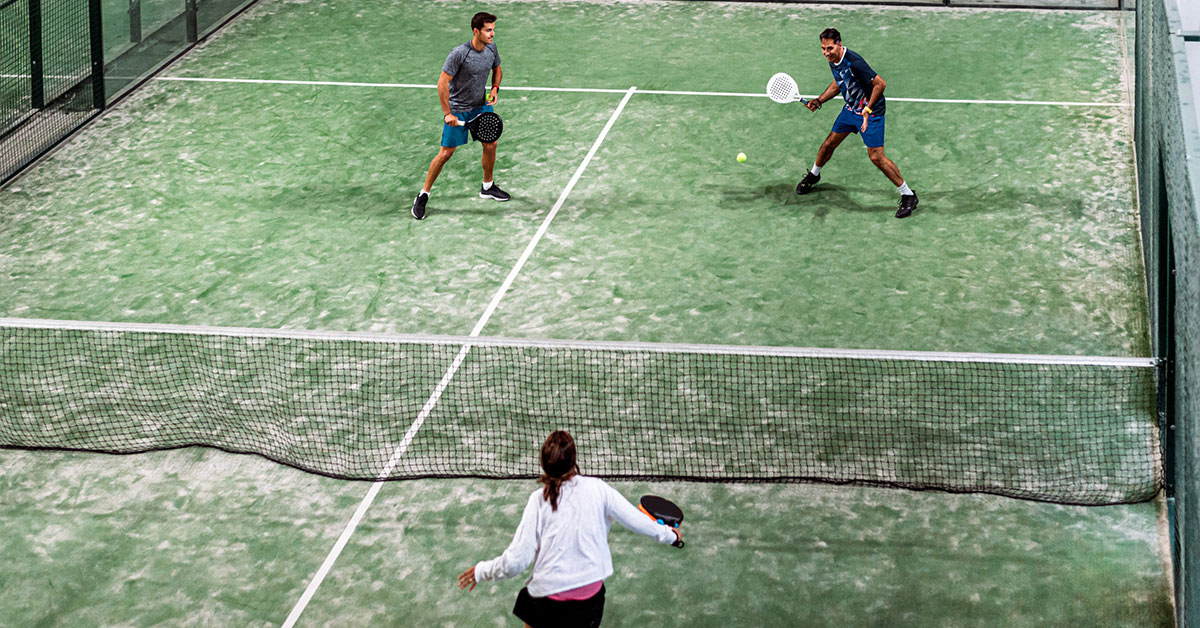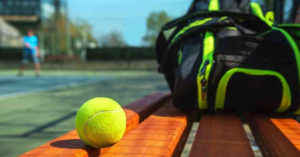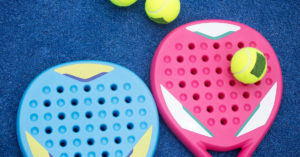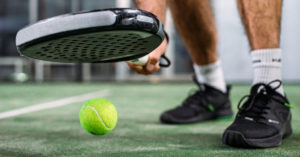Many people get confused between Padel and Paddle tennis. Despite sharing a similar playing environment, Padel is a different sport than Paddle tennis. However, it combines several elements from other sports, such as squash, racketball, tennis, and is gaining popularity.
Padel is a racket sport typically played with 4 players divided over 2 teams and uses the same scoring as tennis. You can easily spot a Padel court by the surrounding glass walls and mesh fencing. Padel also uses typical string-less rackets.
So what is Padel? How to play Padel? What are the rules in Padel? If you want to learn more about a Padel game or its rules and equipment, you have landed on the right page. This article will give a brief insight into the sport and the rules and equipment involved in the game.
So without further ado, let’s get started.
Table of Contents
Background
The Padel sport has been gaining popularity in recent years and has expanded its grasp across different continents. Enrique Corcuera invented the sport in Acapulco, Mexico in the ’60s, which soon caught the attention of several racket sport enthusiasts.
The sport saw a significant response in many regions, and countries like Italy, Spain, and Argentina have dedicated Padel leagues. In 2005, the Spanish Feminine Association of Padel (AFEP) and Association of Professional Players of Padel (AJPP) introduced the Padel Pro Tour.
This professional Padel circuit got a significant response from everyone, and the association renamed it as World Padel Tour (WPT) with a motive of international expansion. Since then, the circuit has traveled across many countries, including Argentina, Dubai, and Portugal.
According to the latest standings, Padel has become one of the fastest-growing sports worldwide, with more than 10 million players within the past few years. Due to its increasing popularity, the sport has reached several countries, including the United Kingdom, Egypt, Singapore, and Denmark.
What is Padel?
Like we mentioned earlier, Padel shares similarities with sports, such as tennis and squash. It employs the same scoring method as tennis and uses similar balls but with less pressure. However, the court is smaller in size and comes with boundary walls made of mesh fencing and glass walls.
Players often get confused when we talk about Padel. Since Padel carries a lot of similarities with tennis.
The sport can also be easily confused with paddle tennis or POP Tennis but both are quite different.
When playing padel you can and hit the ball on rebounds, similar to a game of squash. Additionally, you have to serve the ball below or at the waist level.
It is an energizing and addictive racket sport where players get a unique dimension of playing the ball before or after it bounces of the walls. Since Padel requires minimal skills, it is an ideal sport for players of all ages. However, as your skills improve, you can explore various technical challenges and speed up your game.
Additionally, you will have to improve your match-craft as it is a crucial aspect of the game. This skill helps you earn points as strategy is an integral part of the game rather than strength.
The Padel Court
Padel courts come with glass walls and mesh fencing and have a 10m x 20m rectangular shape. The court also comes with white line-markings that limit that divide field.
Although the sport carries several similarities with tennis, the court is 30% smaller than a tennis court.
It might not seem like a lot but you have to keep in mind that tennis players can cross the lines surrounding the court whereas padel players can not. They would have to climb the tall 2.5m glass walls
Here are the salient features of a Padel court:
- The dimension of a Padel court is 10m x 20m (200m²), which means that the court is 20m in length and 10m wide
- The net is 88cm above the ground and divides the court in the middle into two sides
- The court has glass walls and mesh fencing
- The back and front end of the court feature higher walls (height: 4m)
- The side walls have 3m height
- The net divides the court and has entry points at each end
How to play Padel?
Although it requires minimal skills to play Padel, the sport becomes more technically challenging as you move up to competitive circuits. You will have to improve your match-craft to earn points as strategy is more crucial than strength in Padel.
Since Padel is suitable for all ages, it has gained popularity worldwide in recent years. You don’t require a ton of equipment to play this game, and a ball, two rackets, and two players will suffice your needs. The sport uses a similar scoring system to traditional tennis but except for hitting the ball on rebounds.
Here are the rules of Padel sport.
Play
- When a player hits or serves the ball, it must bounce on the ground without touching anything. The opposite player will have to play the ball before the second bounce, or the serving team will get the point. If the ball hits the wall, the opponent can hit the ball on the rebound.
- Apart from playing on rebounds, the sport also allows the player to use their exit points (gaps on each side of the net) to hit a ball if it goes out of the court. However, the player has to ensure that the ball land on their opponent’s half to make it a valid return.
- If a player hits the ball and their opponent cannot make any contact before or after the rebound, it earns him a point.
- Players can also use volleys in this sport.
- Players can also hit the ball after multiple rebounds from the wall.
- You can play the game in singles or doubles.
- Players use carbon fiber rackets that ensure faster movements, and the ball used in the game is similar to tennis balls but with less compression.
- The main idea behind this sport is the hit the ball in areas where your opponent can’t return the favor. The walls play a crucial part in this sport and add a different dimension to the game. You will have to outplay your opponent by hitting the ball in areas where they cannot hit the ball back.
Serve
- The players start the game by serving the ball to the opposite square. However, you have to stand behind the white serving line before you make a serve. If you fail to do so, you will get a second chance to make a serve.
- Players must serve underhanded and below the waistline. After you place yourself behind the white line or the service box, you have to hit the ball underhanded and diagonally to the opposite square. You will get two attempts for serving, and if you fail, your opponents will get the points.
- If you hit the net while serving, it will be allowed. However, it has to bounce into your opposite square.
Scoring
- Padel uses the exact same scoring method as tennis with few different approaches. For instance, you have to serve underhanded or below the waistline, unlike traditional tennis games.
- You will have to win six games to win a set, and after winning two sets, you win the game. If you get one point, it earns you 15 points, two points make you 30, and three points earn you 40. If you get the fourth point and are two points ahead of your opponent, you win the game. Likewise, you will have to win six games to win a set. However, you will have to stay ahead of your opponents by at least two games to win a set.
- If the teams end up in a tie or six points each, they will play a tie-breaker to decide the winner. The tie-breaker consists of seven points, and the team that reaches that score first wins the set.
- The team that wins two or more sets faster becomes the winner.
What are the things that you cannot do in Padel?
There are several unique things that Padel allows its players to do. The sport enables you to hit on rebounds and run outside the court using the exit doors to keep the ball in play. Additionally, it allows you to employ different and unique strokes to outsmart your opponent. However, there are many things that you cannot do in Padel.
Here are the things you can’t do in Padel:
- While serving, if your ball hits the net and lands on the opposite side, you get a valid hit. However, if your ball hits the nets and grounds on your side, you cannot strike it again.
- Players cannot hit a ball twice in succession regardless of rebounds or open play.
- You cannot touch the net with your racket while playing.
- Players cannot touch the ball with any part of their body except for their racket. If a player touches a ball with any of his body parts or hits a player’s body, the opposite team gets the point.
- While serving, you get two attempts to deliver the service successfully. If you fail both attempts, your opponent will receive the point.
If you commit any of the above faults during a game, your opponent team receives the point. However, these limitations increase a player’s concentration, making the sport more addictive and exciting.
Equipment used in Padel
Like we mentioned earlier, Padel players have to make a minimal investment to start their Padel career. You will have to purchase a Padel racket that is solid and without strings. Additionally, you can identify a Padel racket with its perforated or punctured appearance.
A Padel racket is smaller in size compared to a traditional tennis racket. This smaller size helps players to perform faster movements and reflexes, which is crucial in Padel. Additionally, its lightweight and smaller construction make it easier for everyone to handle.
Padel racket Buyer’s Guide
With a sea of Padel rackets claiming to be the best, choosing one can be tricky. To help you out, we have laid down the things you need to consider before purchasing a Padel racket.
The profile
Playing Padel can be fun and addictive. However, you will hit the floor and wall, especially if you are a beginner. It would be best to choose a racket made of carbon fiber, graphite, or fiberglass. These rackets come with a protective plate for additional strength.
The core
Choosing the core depends on your playing level. If you are a professional and are physically strong, an EVA rubber core will suit you better. However, a Padel racket with an EVA rubber core may not be suitable for beginners, and they should opt for a foam option.
A foam core provides extra power but offers less control. However, an EVA rubber is more durable than foam and is will offer the best experience as you hone your skills. Many manufacturers are developing ways to incorporate these two materials to provide the best of both worlds.
The impact surface
The impact surface of a Padel racket covers the core. Manufacturers use carbon fiber, graphite, or fiberglass in layers to manufacture a Padel racket. If your racket has three layers, it will be durable than those with layers less than three. However, adding three layers reduces the racket’s power and performance.
Weight
Weight is one of the crucial deciding factors when choosing a Padel racket. A heavier racket will allow you to hit hard, while a lighter racket will allow more maneuverability. It would be best to select a racket that suits your skills and how comfortable you feel using it.
Balance
The balance of a Padel racket is crucial to hone your skills. Padel rackets typically come in 3 kind of shapes: round, teardrop or diamond.
- If you are a beginner and choose a diamond-shaped Padel racket, you will have difficulty controlling the power.
- Likewise, a teardrop-shaped Padel racket may not justify the skills and techniques of a professional player.
Read more about how to choose the perfect balance of your padel racket.
Thickness
Padel rules state that players cannot use rackets thicker than 38mm. You have to choose a racket that has a thickness between 36mm to 38mm. While thicker rackets provide you with more power, thinner ones will offer better control and maneuverability.
Thinner rackets (36mm) will be perfect for beginners, while thicker ones (38mm) provide the necessary power for advanced players. However, juniors can use Padel rackets that are 35mm thick.
Conclusion
Padel is growing as one of the most addictive sports in the world. Although it has not seen a widespread reach globally, its attractive and addictive gameplay can put it among the world’s top sporting events.
Its professional circuit is growing and reaching different regions, with many countries staging their separate and dedicated leagues. While the number still grows, we believe that Padel will accumulate more players in the coming years.










